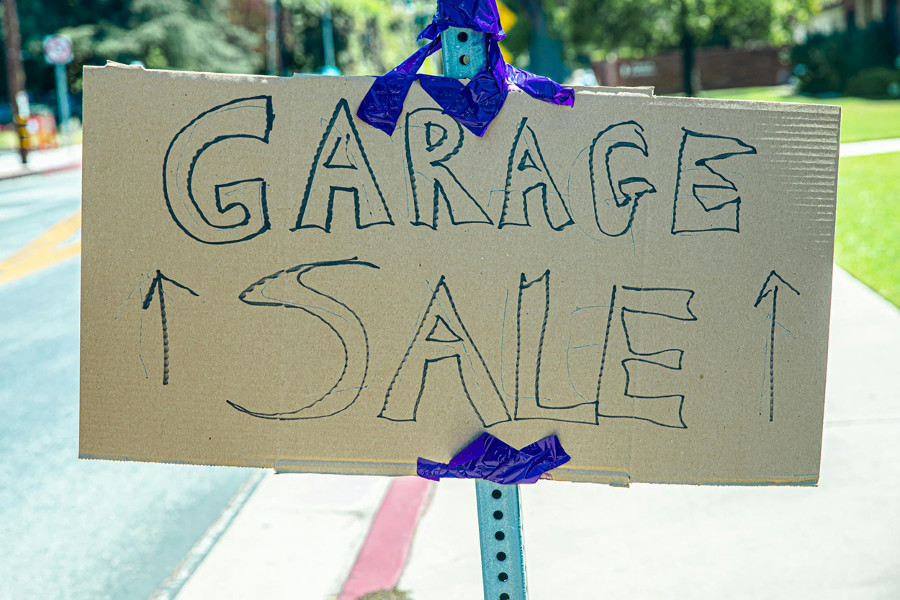Turn Your Clutter into Cash: How and Where to Sell Your Unwanted Items
We all accumulate stuff. Over time, our homes get cluttered with things we no longer need. But what if instead of just throwing it all away or letting it gather dust, you could make a little extra cash by selling it? It’s not just about clearing space - it’s about finding new life for the things you no longer use and maybe even getting a few dollars in the process. Here’s how to take those items, declutter your space, and turn your clutter into cash.

We live in a world where we often hold on to things “just in case.” Maybe you’ve been hanging on to that sweater from 5 years ago or that old phone because it still works. But when was the last time you actually used it? Getting rid of what no longer serves us can feel liberating. Not only does it make your home feel lighter, but you can also put your unwanted items into the hands of people who will appreciate them. The trick is knowing where to sell, how to sell, and which things are worth the effort.
1. Assessing Your Items: What Should You Sell?
Before you rush to post everything online, it’s worth taking a step back and figuring out what’s actually worth selling. Not everything you no longer need is going to bring in cash.
The Decluttering Process:
Start by going through your belongings - bit by bit - and really think about each item. If you haven’t used it in a while, it’s probably time to let go. Ask yourself: "Would I buy this again?" If the answer is no, chances are someone else might want it.
Categories of Items to Consider Selling:
- Clothes & Accessories: We all have clothes hanging in the back of our closets that we rarely wear. Designer or gently used fashion items can sell well.
- Electronics: Old phones, tablets, laptops, and cameras don’t just collect dust - they can be sold for a decent price.
- Furniture: That couch that doesn’t quite fit your new living room? Someone else might love it, especially if it’s still in good shape.
- Books & Media: Whether it’s a first edition or a random collection of novels, books are always in demand.
- Collectibles: Things like action figures, vintage toys, or memorabilia can be worth much more than you think.
Common Items That Don’t Sell Well:
While it’s tempting to sell everything, some things just don’t move. Avoid listing:
- Broken or damaged items (unless you plan to repair them).
- Old electronics that no one’s asking for anymore.
- Expired items (food, medications, etc.).
- Overused items that have clearly seen better days.
Tip:
Think about whether your item still holds value in the eyes of others. If not, it might be time to let it go - whether that means recycling, donating, or tossing it.
2. Online Platforms: Where to Sell Your Stuff
The internet has made it easier than ever to sell your unwanted goods. The trick is knowing which platforms work best for the types of things you're trying to sell. Each platform has its own audience and focus.
Popular Marketplaces and Apps:
- eBay: If you’ve got something rare or collectible, eBay is a good option. From old tech to vintage clothing, it’s a great platform for items that need a specific market.
- Facebook Marketplace: Need to sell a couch or an old washing machine? Facebook Marketplace connects you with buyers nearby - no shipping required.
- Craigslist: A classic. Whether you're selling a mattress or a bicycle, Craigslist is straightforward and effective for local buyers.
- Poshmark, Depop, and ThredUp: These platforms are tailored for fashion, so if you’ve got gently used clothes, shoes, or accessories, they’re your go-to.
- Etsy: If you’re selling something handmade or vintage, Etsy is the place. Think vintage jewelry, unique furniture, or handcrafted goods.
Pros and Cons of Online Platforms:
Pros:
- Reach a broader audience: You’re not limited by geography.
- Convenient: Post an item, set your price, and wait for interested buyers.
- Specialized buyers: Certain platforms attract buyers who are specifically interested in what you’re selling.
Cons:
- Shipping hassles: Some platforms require shipping, and you’ll need to factor in packing and postage costs.
- Competition: There’s a lot of stuff for sale, so your item needs to stand out.
- Fees: Many platforms take a cut of your sale, which can eat into your profits.
3. Selling Locally: In-Person Options for Fast Sales
Selling items locally can help you skip the whole shipping process - and maybe even get a faster sale. Here’s where to look:
Garage Sales:
An old-school option that’s still incredibly effective. You don’t need to have everything listed online - just set up shop in your driveway, and you can make cash from old clothes, books, furniture, and more.
How to Prepare:
- Advertise your sale ahead of time. Share it on social media or post signs around the neighborhood.
- Group similar items together - books with books, clothes with clothes - to make browsing easier.
- Be ready to haggle. People often expect to bargain at garage sales, so price your items a little higher than the lowest offer you’ll accept.
Consignment Shops and Thrift Stores:
For higher-end or designer items, consignment shops can help you sell your stuff. They’ll take a percentage of the sale, but if you have quality goods, it’s a hassle-free way to get rid of things like clothes, furniture, or even artwork.
Flea Markets:
If you’ve got a lot of items to sell and want to reach local buyers, a flea market is worth considering. You’ll have to pay for a booth, but if you’ve got a variety of goods, the foot traffic could work in your favor.
Pawn Shops:
If you need quick cash and are selling items like jewelry or electronics, pawn shops can be a quick solution. However, they’ll usually offer you less than you’d get from a private sale.

4. Niche Marketplaces for Specific Items
Some items do better on specialized platforms. If you've got something that fits one of these categories, check out these niche marketplaces:
Selling High-End or Designer Goods:
- The RealReal and Tradesy are fantastic for luxury fashion, high-end handbags, and designer clothes.
- ThredUp is a great platform for selling gently used clothing, especially if it’s in good condition.
For Books and Media:
- BookScouter helps you find the best price for textbooks, novels, or even rare editions.
- musicMagpie, WeBuyBooks and CeX are great for CDs, DVDs, and games - especially if you want to clear out your media collection.
For Tech and Electronics:
- Gazelle lets you sell used phones, laptops, and other tech. They make it easy, and you don’t have to deal with the hassle of finding a buyer on your own.
For Collectibles:
- If you’ve got vintage toys, art, or rare memorabilia, eBay is your best bet. Specialized auction houses are also a good choice for rare, high-value collectibles.
5. How to Sell Effectively: Tips and Best Practices
The key to selling your unwanted items quickly is making them appealing to buyers. Here’s how to do that:
Setting the Right Price:
- Do some research. Check what similar items are going for. Don’t price too high or too low - aim for fair market value.
- Don’t overprice. A high price might scare off buyers, but a low one might leave you feeling undervalued. Find a sweet spot.
Writing Descriptions That Sell:
- Be clear, concise, and honest. Don’t just list the basics - highlight what makes the item stand out.
- Photos are everything. Good lighting and multiple angles make a huge difference. No one wants to buy a couch they can’t fully see.
Negotiation Tactics:
- Be prepared for negotiations. Know your lowest acceptable price, but don’t be afraid to entertain reasonable offers.
- Stay polite and flexible. The goal is to move your stuff, not to win a sale.
Payment Options and Shipping:
- Use secure payment options like PayPal or Venmo for online transactions.
- If you're shipping, make sure you pack items well - especially fragile ones. Consider adding tracking numbers so both you and the buyer can follow the shipment.

6. Preparing Your Items for Sale: Presentation Matters
The way you present your items can make all the difference in how quickly they sell.
Cleaning and Restoring Items:
Make your items shine. Clean those shoes, dust off that bookshelf, and wash any clothes. It’s worth taking a little time to spruce things up before listing.
Repairs:
If an item can be fixed easily, it’s worth doing so. A small repair - like stitching a torn jacket or replacing a broken button - can add value.
7. Common Mistakes to Avoid
Even seasoned sellers can make mistakes. Here’s how to avoid the most common ones:
Overpricing Items:
Price your items based on their condition, demand, and market value. Don’t assume they’re worth more than they are.
Not Taking Photos or Using Poor Quality Images:
A blurry or poorly lit photo can make your item look less desirable. Take a little extra time to make your items look great.
Failure to Communicate Clearly:
If someone messages you about an item, respond quickly and with clarity. Make sure your buyer knows exactly what they’re getting.
8. How to Handle Unsold Items
Not everything will sell, and that’s okay.
When Items Don’t Sell:
Lower the price, re-list them, or try bundling items together to sweeten the deal.
Alternatives to Selling:
If your items just won’t move, consider donating them to charity or recycling them. There’s no shame in passing things on to someone else who might need them.
Making Decluttering a Routine:
Once you’ve finished decluttering, make it a regular habit. Check your home every few months and see if there’s anything else you’re ready to part with.
Conclusion:
Selling your unwanted items isn’t just about making extra cash - it’s about freeing up space and giving your things a second life. Whether you’re using online platforms or selling locally, there are endless opportunities to turn your clutter into cash. So go ahead - clear out those closets and make room for something new. You never know what could sell, and you just might be surprised by what you can earn.



